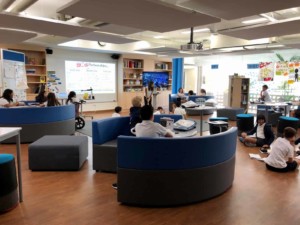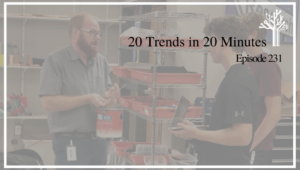7 Ways to Boost Your K-8 Math Program

By Caralee Adams
This blog was first published on edupulse.
At Leckie Elementary School in Washington, D.C., math is no longer an abstract subject that is just about coming up with the right answer.
Now students learn about fractions by figuring out recipes and serving sizes for a Thanksgiving meal. Teachers allow time for “math talk” where kids grapple aloud with concepts—sometimes veering off track to debate whether zero is a number, says principal Atasha James.
Also at Leckie, the use of educational technology helps personalize instruction, and students rotate to separate classrooms to learn from teachers who have developed an expertise in math, reading or writing.
“The effect was transformative to our school climate,” says James about Leckie, a public school of 525 students (PreK–6) in southeast Washington. “It feels so good to see teachers walk with such a swag and confidence about what they can do. The efficacy is high because they know their stuff.”
Last year, performance and growth among Leckie students in the blended-learning math program i-Ready® was above the national median. And across the district, test scores are rising as schools change their approach to math instruction.
In 2003, just seven percent of fourth-grade students in the District of Columbia Public Schools were performing at or above the National Assessment of Educational Progress proficient level. But by 2015, 33 percent were doing so. During that same period, the percentage of students at or above the NAEP basic level in math rose from 36 percent to 68 percent.
School leaders in this rapidly improving school district with a high-poverty population share what has worked in their schools to boost math performance district-wide among K–8 students.
1. Change expectations.
The district has worked hard for years to eliminate the notion that someone is just “not a math person,” says Brian Pick, chief of teaching and learning for DCPS. “Everybody is a mathematical thinker. They are just in different places on the journey. It’s super important for our educators to have a growth mind-set so that they are projecting that onto students.”
As an early adopter of the Common Core, the district has used the new math standards to focus on advanced mathematical thinking, persevering through difficult problems and focusing on real applications of math.“It’s a little different from the traditional ‘three Rs’ approach to education and saying you just need to know your arithmetic,” says Pick. “It’s about solving problems and articulating how you solve them.”
2. Make math relevant.
At DCPS, kindergarteners learn to analyze shapes by designing monuments for the National Mall, and second graders do projects where they are event planners and create budgets for big parties. In middle school, one lesson places a giant pencil on a table, and the class is told a new student has arrived and they have to figure out the giant’s height based on the size of the pencil.
“These problems spur curiosity—there is no one way to get to the answer,” says Pick. “Getting an answer is important but just as important is figuring out the different ways to get to that answer.”
The hope is to design real-world projects that are fun and engage students because they can see the relevance of what they are learning. Lesson plans explicitly link tasks in math to jobs, for example, with a video showing an architect working on a floor plan.
3. Invest in teacher collaboration.
In the past few years, the district has helped teachers form professional learning communities by subject and grade. For instance, all second-grade math teachers are trained in regular 90-minute learning seminars. They work through the math to gain a deeper understanding of the material and collaborate as a team on lesson plans.
“As important as the curriculum is, more important is working with educator groups to combine the art and science of teaching to make it happen with your kids in the classroom in an urban setting—particularly with students who are not all on grade level,” says Pick.
When teachers spend time learning together, they develop “nimbleness” with math, which allows them to be more effective in helping students, says Pick. “A deeper understanding of math, particularly among elementary teachers, will pay off in students’ understanding of the math.”
4. Embrace blended learning.
All schools in DCPS have access to blended learning—a model that combines independent online work with classroom instruction. Teachers can use information from students’ individual diagnostic assessments to differentiate instruction.
“It’s really pushed the adult learner in thinking outside the box and seeing every student as [having] the same needs,” says Andre Samuels, principal at Browne Education Campus, a public school in the district that serves kids in grades third through eighth. Teachers focus on grouping students and addressing their particular strengths and weaknesses.
Prior to adopting a blended learning program four years ago, Browne didn’t have a uniform way of diagnosing students’ individual skills. Pick says these tools make a teacher’s job easier, enabling targeted instruction that engages students.
The district uses programs such as i-Ready and ST Math, which have a good combination of what Pick calls “steak and sizzle.” Some educational technology can be too much steak (boring) and others too much sizzle (entertainment). Ideal are programs with puzzles and problems, where there is intrinsic motivation for students to progress, he explains.
5. Use and share data.
With personalized learning and frequent assessments come a slew of reports and data that have the potential to influence the educational process—if they are shared and utilized.
“The data cannot just sit in a report. It’s about analyzing, sharing, and discussing the data, and then the action after. And the action is ever-changing,” says Samuels. The information needs to be disseminated widely and clearly— including at parent–teacher conferences.
“The parent can now have a more detailed and informed conversation about student growth and achievement,” says Samuels. “It is not just an educator-led initiative. It is a collaboration of the educator, the student, and the parent or guardian.”
6. Get everyone on the same page—but be flexible.
One of the biggest benefits of technology is that it allows better tracking on a district-wide and school-wide level to ensure equity. Ongoing data on student math performance, for example, allows the district to troubleshoot where schools are struggling and to identify schools that are making progress, notes Pick.
However, there is a not a “one-size-fits-all” approach to blended learning, he says. The district tries to work with schools to set up the best models for their particular building, size, needs, and approach—whether computers are used as a whole-classroom tool, in a separate lab, or in a one-to-one program.
Within a school such as Browne, school leaders say that having the same online learning program has allowed teachers in different grades to have a common language around math and improve vertical alignment. In past years, there was no real systematic way of assessing students, but now educators get a holistic portrait of the student and quarterly updates that closely track performance.
7. Celebrate success.
As students progress at their own pace with a specialized blended learning program, Samuels says it can increase motivation. “They have more personal celebrations, where they can see their improvement,” says Samuels. “It makes their learning innate. It makes them want to improve and grow—and to achieve.”
Next year, school leaders at Browne are considering posting charts of students’ success outside the classrooms or holding biweekly assemblies to give students certificates to recognize achievement.
As students advance and take ownership of their learning, says Brandon Johnson, a fifth-grade math teacher at Browne, they are gaining confidence. The blended learning model allows them to slow down the pace until they fully grasp the concept and then move ahead when they’re ready, he says: “Now there is less fear about math.”
For more, see:
- Why “I’ll Never Use This” Doesn’t Apply to 21st-Century Math Skills
- Mathematical Modeling For High School Students
- 3 Ways to Reboot Remedial Math Class
Stay in-the-know with all things EdTech and innovations in learning by signing up to receive the weekly Smart Update. This post includes mentions of a Getting Smart partner. For a full list of partners, affiliate organizations and all other disclosures please see our Partner page.







0 Comments
Leave a Comment
Your email address will not be published. All fields are required.